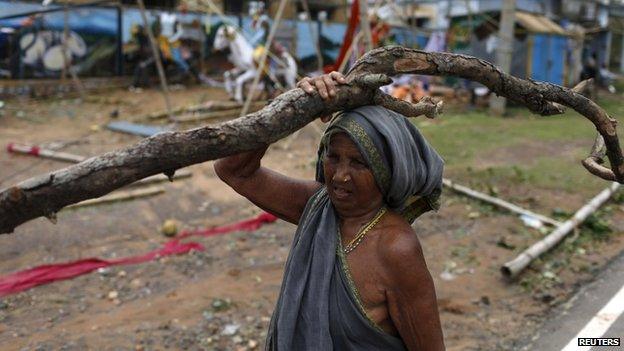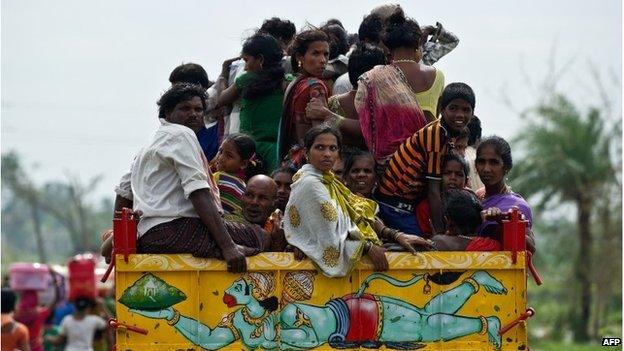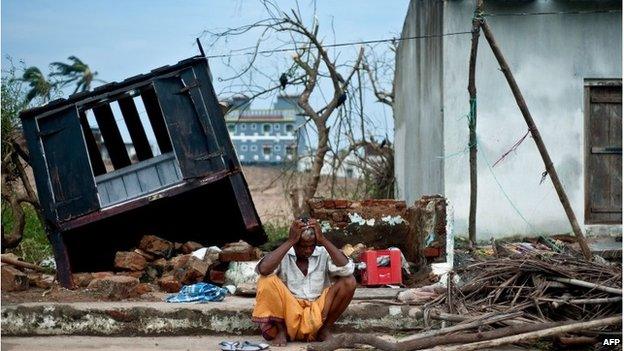India's Cyclone Phailin leaves trail of destruction
- Published
Watch: The BBC's Andrew North walked some of the affected areas, where one local woman was using an axe to try and clear felled trees from her home
Indian disaster teams have begun a relief operation after Cyclone Phailin crashed into eastern areas, forcing up to one million people to flee.
Officials are assessing the damage and providing food to hundreds of thousands who spent the night in shelters.
The cyclone wrecked many coastal homes, uprooted trees and blocked roads in Andhra Pradesh and Orissa states.
Eighteen people have been killed. All but one of the deaths were in Orissa, a senior state official told the BBC.
"We have been able to [keep] the death toll to a bare minimum," Marri Shashidhar Reddy of the national disaster management authority told reporters in Delhi.
In 1999 a cyclone killed more than 10,000 people in Orissa.
But the authorities said they were better prepared this time.
The BBC's Sanjoy Majumder in Berhampur, Orissa, says they made a massive effort to get the message out to people, many of whom were reluctant to leave their homes.
The massive storm made landfall on Saturday, packing winds of about 200km/h (125mph).
It was weakening on Sunday as it made its way north-west.
In Orissa's state capital, Bhubaneswar, crews were using axes and rope to clear fallen trees from roads.
"We've just started to assess the damage and coastal areas will have fared worse," said crew leader Upendra Malik.
The storm tore down power and communication lines and knocked out road and rail links, making an assessment difficult.
An estimated 5,000 sq km of mostly paddy crops have been destroyed, causing a loss of some $320m (£220m).
The coast guard said it had rescued 18 fishermen who were stranded at sea, as well as 18 crew from a cargo ship carrying iron ore that reportedly sank during the storm.

Indians began clearing roads and assessing the damage done by Cyclone Phailin.

Some of those evacuated ahead of the cyclone were returning home

The storm was the most powerful to hit the region since 1999, when more than 10,000 died.

There was widespread damage to homes and infrastructure along the coast
Several of the dead were killed by falling trees, but officials were confident that a massive loss of life had been avoided.
"We were preparing for a super cyclone, but Phailin did not turn into a super cyclone," disaster official Tripti Parule told the AFP news agency.
He said the evacuation was the biggest in India's history for such an event.
The Times of India reported that a storm surge more than 3m (9ft) high had flooded areas of Ganjam, Khurda, Puri and Jagatsinghpur districts of Orissa and the Srikakulam district of Andhra Pradesh.
India's National Disaster Response Force (NDRF) said 1,200 personnel had been deployed to Orissa and 500 to Andhra Pradesh.
"The teams have medical first responders [for first aid] and heavy cutting equipment. In the case of cyclones there is a likelihood of collapsed buildings."
Up to 25cm of rain is predicted for Orissa and the north coast of Andhra Pradesh throughout Sunday and Monday, forecasters said.
In the coastal town of Gopalpur, one of the worst-affected areas, hundreds of terrified residents spent the night huddled in shelters, schools and public buildings.
Witnesses reported seeing shards of glass and asbestos sheets flying through the air as the cyclone struck.
Shop signs and other debris were being pitched high in the air by storm gusts and elaborate decorations for a major Hindu festival were strewn over the main road.

- Published12 October 2013
- Published12 October 2013